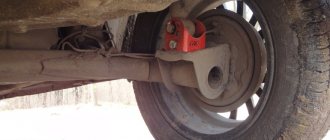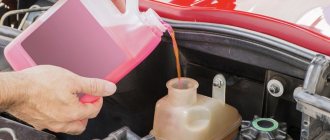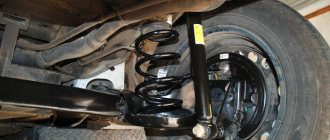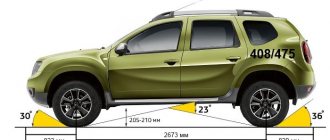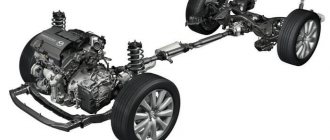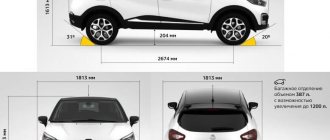The answer to the question “what is a car’s ground clearance?” simple - the minimum height of the middle part of the car from the surface. That is, the distance between the bottom and the road.
Actually, not just a car. Any vehicle. There are special tractors with a ground clearance of two meters. And the tank’s high ground clearance makes it more visible and vulnerable in battle. Although cross-country ability is a very important quality for him.
Advantages of cars with low clearance:
- excellent road holding. A low center of mass helps with cornering stability. All racing cars are like that;
- efficiency. All other things being equal, the drag is slightly lower, which saves fuel;
- "fuzzyness". The sporty, fast-looking silhouette of the car warms the soul of the owner.
The advantage of cars with high ground clearance. One thing, but a very significant one. Patency. Such a car will not sit on its bottom in bad conditions. It will travel in the direction that roads still exist in our place. Easy parking - it won’t catch a curb or a stone in a snowdrift.
It is significant that high ground clearance raises the center of mass of the car, making it prone to tipping over on sharp turns. Therefore, when driving on good roads at high speeds, it is worth reducing it.
Based on clearance height, cars are conventionally divided into:
- passenger cars –110-180 mm. We take into account that the average height of the curb is 16 cm;
- crossovers, SUVs - 160-220 mm;
- SUVs – 200-420 mm.
Alas, it's not that simple. There is also such a thing as “body geometry”. A long car with a high body can give up even before entering a tow truck. And the Peugeot 107 easily climbs up or down a hill, goes around the pits along the contour, without touching anything.
The VAZ-2131, having lengthened by half a meter from the classic Niva, acquired the harmful ability to regularly cling to something.
VAZ-2131
More. The bottom is not a solid plate. It’s worth inspecting your car on an overpass; knowing where and how much the parts protrude, you can carefully “skip” a post or stone under the bottom.
For family cars with high ground clearance, we can recommend the Volkswagen Polo Sedan 1.6 with a height of 170 mm.
Volkswagen Polo Sedan 1.6
Relatively inexpensive, roomy, passable. When choosing a family car, you should look beyond ground clearance, even if the choice is based on operating conditions. We take into account price, efficiency, trunk size, cost and availability of maintenance.
When looking for a model of an economical car with high ground clearance, you should take into account the contradictory requirements: low cars are more economical. So we are looking for a reasonable compromise in the requirements. You can pay attention to the “C3 Picasso Trekker” with a clearance height of 175 mm or Nissan Juke – 180 mm. All-wheel drive, automatic transmission, high engine power on average increases fuel consumption.
Nissan Juke
Among inexpensive, budget cars with high ground clearance, the Russian Lada 4×4 and Chevrolet Niva are interesting. Similar to each other - mechanics, all-wheel drive, 1.7 liter engine with 80 horses - cars with excellent cross-country ability.
Chevrolet Niva
The Chinese are doing quite well in the budget class, making quite decent cars at a relatively low cost.
Ways to increase ground clearance
How to increase car clearance. There are cars with active suspension. Their design includes the ability to change the height of the car literally “on the fly”, raising or lowering depending on driving conditions.
Hydraulic, pneumatic and hydropneumatic systems are controlled by an on-board computer. Provision is made for raising and lowering each wheel depending on the conditions: at different cornering speeds, uneven roads, at the start, braking. Installed sensors assist the movement without driver intervention.
Adjustable Air Suspension (ESS)
Cars equipped with such systems move smoothly, driving is more comfortable and safer. Alas, you have to pay for everything. Both in the literal sense: such models are more expensive, and in the figurative sense - the complication of the design leads to more complicated maintenance and reduced reliability.
A simple way to increase the car's ground clearance is to install different wheels.
It has nuances. Wheels 195/65R15, 205/55R16, 225/45R17, 225/40R18 have almost the same external size. It is necessary to take into account the change in the rubber profile, choose the same profile, but with an increased radius.
There are also failures caused by geometry. With the same number of wheel revolutions, the distance the car travels is different. That is, irregularities in the speedometer readings are possible. The speed sensor is likely to fail in vehicles equipped with ABS and ESP systems, if any. And it won’t be possible to increase it much - the wheel arches will interfere, possibly touching the mudguards.
Another option is to replace the springs and shock absorbers, and supply additional “gaskets”. Many workshops now provide such services. We take into account that the replacement of standard components of the car automatically leads to the loss of the factory warranty, if it has not yet expired. Such replacements also affect the stiffness of the suspension.
It is also worth considering one not very good, often encountered and rarely taken into account minus. Any repair or tuning of a car is fraught with encounters with cross-eyed repairmen. Moreover, outwardly you cannot distinguish them from conscientious workers. Such a meeting easily leads to loss of money, nerves, and time. Theoretically - and life, well, this is in very rare cases.
A car “raised” by tuning, in comparison with the purchased base model, can noticeably lose stability. When entering a corner at speed, the difference is noticeable.
- Video: installing spacers to increase the ground clearance of the Kia Ceed Sportage 3.
- Video: increasing the ground clearance of the Mazda3 due to spacers, shows what happened and how it turned out.
All SUVs are vehicles with high ground clearance. For ease of selection, familiarization and comparison of different models and brands of cars, look at the numbers below.
Tables for comparing clearances
When buying a car, you can decide in advance on the ground clearance. The two tabular forms below will help you with this. See and choose your size.
Car clearance - comparison table. This form shows the difference between cars and SUVs:
Below is a table of the most purchased class B cars; ground clearance increases from bottom to top. Compare the ground clearance of different models and manufacturers, and choose the best option:
The stated ride height does not always correspond to reality. For example, it is clear that a loaded car will “sink” lower than an empty one. According to Russian GOST, measurements are taken in a vehicle loaded to the maximum permitted weight.
And at the Russian representative office of Mitsubishi, when asked by Avtovestya, they answered that the measurements are carried out on a loaded car. That is: there is no driver and passengers, the fuel tank and windshield washer reservoir are filled, there is a spare wheel and a set of tools, a jack. Just a car standing on a stand.
The underbody protection installed in the car “eats” a few more millimeters. Again, the clearance is indicated with the protection removed.
Video: measuring the ground clearance of the Skoda Rapid.
Underbody protection
Additional protection for the bottom of the car is possible. The options are different. There is simply anti-corrosion protection, usually coating with various mastics, paints and the like.
This is not a superfluous thing, since when driving, grains of sand and fine gravel treat the bottom of the car like an abrasive. Using salt on the roads in winter also does not add longevity to the body.
But you can also order more expensive protection that protects the engine crankcase (one of the most expensive repairs), gas tank and other parts from impacts. Theoretically, at least from mine fragments, like on armored personnel carriers. The installation of additional protection itself will slightly reduce the ground clearance, but will save you from significant expenses for repairs.
How does clearance affect a car's maneuverability?
The vehicle's ground clearance, first of all, affects its cross-country ability and stability: the larger it is, the higher the vehicle's cross-country ability. But since the center of gravity in this case is located high, the stability and controllability of such a car when driving is low.
And vice versa, the lower the ground clearance, and, therefore, the lower the center of gravity of the car (look at Formula 1 cars), the higher the maneuverability, stability on the road and the higher the speed at which you can drive. True, the cross-country ability of such a car will suffer.
With low ground clearance, cars look beautiful, with a sporty touch in character, and driving cars with low ground clearance is pleasant. The car takes turns like a glove, without rolls or dives, and holds the road perfectly. The only negative is that our roads in Russia are not at all designed for low-clearance vehicles. But despite the terrible condition of the roads, there is now a fashion for cars with lowered suspension.
Owners of Prior and other cars of the ninth family reduce the ground clearance of their cars with the help of tuning to the minimum values. They ride around and imagine themselves as Schumachers. And the most consumable material for them was the gas tank, which some manage to puncture several times a year.
But a car with a lowered suspension looks sporty and beautiful.
Car clearance, what is it, is it possible to increase the car’s clearance. How to increase car clearance?
Most car owners believe that the higher the ground clearance, the better. However, this rule does not always work. There are extreme sports enthusiasts who set themselves the completely opposite goal - to lower the suspension. What is clearance? How to measure it yourself? What methods exist for adjusting clearance? More on this later in the article.
What is car clearance
Ground clearance is one of the characteristics of a car, which indicates the distance between the lowest point of the bottom of the vehicle and the surface of the road surface.
The ground clearance is measured in centimeters using a regular tape measure. Ground clearance is no less important characteristic than the width and length of the car.
This value affects the stability, maneuverability and cross-country ability of any vehicle.
The lowest point of a vehicle can be different parts, which directly depends on the design of the car. On some vehicles, the lowest point may be the protruding part of the exhaust system.
In addition, there are cars whose lowest part is the spare wheel (in vehicles where the spare tire is attached to the bottom of the car). As a rule, these are SUVs, crossovers and SUVs. In other cars, the lowest point is the suspension, front bumper, and some parts of the engine compartment.
Quite often it is the front bumper that suffers first, especially if there is an additional body kit.
High ground clearance car, pros and cons
Cars with high ground clearance have only one advantage, but a very significant one - cross-country ability, especially considering the quality of the roads in our country.
As for the shortcomings, there are some here too. Increased clearance raises the vehicle's center of mass, making it prone to rollover during sharp turns.
Therefore, when driving at high speeds on good roads, the ground clearance must be reduced.
Low clearance car, pros and cons
Firstly, cars with low ground clearance handle the road well. A low center of mass makes the car more stable when cornering. Secondly, such cars are more economical. Thirdly, they look very sporty, which warms the soul of the owner.
But you won’t be able to drive such a car on our roads for a long time; it will be especially difficult to pass speed bumps, not to mention the fact that any hole or other unevenness in the road surface can lead to damage to an important element of the car, for example, the engine, exhaust or chassis system.
What is the ground clearance of a car, how to measure the ground clearance of a car
Information about the vehicle's ground clearance is indicated in its technical passport. But, if you decide to measure it yourself, you need to perform a number of certain actions.
First of all, the car must be driven into the inspection hole. It is very difficult to take high-quality measurements without being able to crawl under the car.
To ensure the most accurate measurement, make sure that the ramps on the pit are level and that the tire pressure meets the standards for your vehicle.
Next, you need to clean the interior of heavy objects that could affect this value. To measure, use a tape measure or a regular ruler. To obtain the most accurate data, measurements should be taken in several places, that is, at the lowest points. The places under the engine crankcase and under the axles are considered starting points.
Ground clearance table for cars
Based on the clearance height, vehicles are conventionally divided into:
- Passenger cars - 110-180 millimeters.
- SUVs, crossovers - 160-220 millimeters.
- SUVs - 200-420 millimeters.
When purchasing a car, it is advisable to familiarize yourself with the table below, which shows the difference between SUVs and cars.
Below is a table of the most purchased class B cars. Compare the ground clearance of different manufacturers and models, and select the most optimal option.
Car clearance, how to increase the clearance with your own hands, ways to adjust the clearance
Option one. The simplest option is to replace standard tires with tires with a higher profile. This is the fastest and, as many believe, the most painless solution for the vehicle chassis. But, given the significant cost, this solution is not very effective.
A slightly greater effect is achieved by increasing the diameter of the discs. Please note that you should not install tires and wheels with a diameter larger than those provided by the vehicle manufacturer. Exceeding the values leads to increased load and rapid wear of wheel bearings, shock absorbers, struts, and so on.
The second option is to replace worn out shock absorbers. There is an opinion that it is possible to increase the car's ground clearance using such a replacement. However, in fact, this is not entirely true.
After all, when the car is stationary, its body hangs on the springs, therefore, the shock absorbers do not have any effect on the rise. They are triggered when driving, when leaving a curb or swaying.
Thus, shock absorbers do not affect the increase in ground clearance.
The third option is to raise the rear of the car using rubber spacers that are mounted on the spring instead of the standard ones made by the manufacturer. These spacers can support the weight of the vehicle and are not subject to deformation.
Is it possible to use this method to increase the ground clearance of a car without deforming the body, without experiencing discomfort while driving and without causing corrosion and oxidation? The clear answer is yes! In addition, this option is considered one of the safest both for the design of your car and for driving.
The fourth option is to install spacers between the rear beam eyes and the lower mounts of the rear shock absorbers. We are talking about the so-called. "houses".
This method is convenient because you can choose the clearance height yourself due to the holes in these spacers. This solution is inexpensive and fast.
But do not forget that after this event you will need additional adjustment of the headlights, brake force regulator, and the angle of the steering axis of the front wheels.
The fifth option is one of the worst methods to increase ground clearance at home. The old springs are dismantled, and instead reinforced springs are installed, either home-made or not corresponding to the given vehicle model.
At the same time, the body hangs on springs, and the shock absorber travel is either reduced or absent, which leads to breakdown. In addition, the movement becomes uncomfortable, the suspension cannot perform its functions as a result of the lack of the required work of the shock absorbers, which worsens the car's handling and increases the braking distance.
The sixth option is reliable, simple and inexpensive. An interturn insert is mounted into the spring. As a result, the compression ratio of the spring decreases, which entails the consequences described in the fifth option.
The seventh option is to increase ground clearance by installing polyurethane inserts between the strut support and the car body. As a result of increased rigidity, this method has an increased impact on body wear when driving on uneven roads.
The eighth option is the installation of aluminum spacers between the car body and the support.
Does the vehicle's ground clearance actually match the manufacturer's stated ground clearance?
But the truth is, you should always remember and not forget that the ground clearance declared by the automaker itself does not correspond to the real data. As we said above, the ground clearance in a car is measured by car companies on an empty car and not loaded with luggage. Thus, keep in mind that in real conditions the vehicle’s ground clearance is always less than indicated in its technical specifications.
But the worst thing is that the ground clearance that is indicated in the specifications for the car, as a rule, does not take into account the engine crankcase protection itself, which is installed by the manufacturer or buyer on the car. As a result, it turns out that any car has this ground clearance in fact and specifically 10 - 30 mm less. But in the end, we have the following: many passenger cars presented for sale today on the Russian car market, in the literal sense of the word, imperceptibly turn into that particular “grinder” for rolling snow on the road.
For example, if your car, according to the automaker, has good ground clearance, say 160 mm, then even if you install plastic protection on it, your car will lose approximately 10 - 15 mm of ground clearance. Thus, in the best case, your car will no longer have 160, but only 150 mm of ground clearance.
Plus, don’t forget, friends, that official data on ground clearance does not take into account the total load on the body. Therefore, keep in mind that if a driver and three passengers with luggage get into the car, then you can safely say goodbye to at least another 3 - 5 mm of ground clearance. As a result, ideally, from 160 mm of ground clearance, you will only have 147 mm of this ground clearance left in your car. And in the worst case - all 140 mm. And this, friends, is not the same as a clearance of 160 mm. It is especially offensive when, when buying a car, you had a certain hope and the main criterion for such a choice for you was the ground clearance of the car.
Yes, of course, when buying a car with low ground clearance, you can naturally not install engine protection. But then you specifically risk damaging the crankcase of the car’s power unit. This is especially true on our Russian roads, which love to present unexpected surprises to drivers.
So we remind you once again, friends, the lower the vehicle’s ground clearance, the more reliably the engine crankcase protection should be installed below. Unfortunately, this reliable and high-quality engine crankcase protection will in any case eat up sufficient millimeters of ground clearance from any car. As a result, it turns out that owning the same sedan car in winter can become a huge problem for its owner.
Let's find out, friends, taking into account the above information, which cars on sale in our country are not suitable for use in winter on our harsh Russian roads. We have selected for you, friends, the “Top 10” cars with the lowest ground clearance, the operation of which in winter is problematic in Russia.
10) Mercedes-Benz E-Class (W212)
Ground clearance according to specification: 150 mm (with AMG body kit - 135 mm).
Real ground clearance: 130 mm (with AMG body kit - 115 mm).
The popular Mercedes-Benz E-Class sedan in Russia in the W212 body gives its owners an unforgettable level of comfort and controllability. This car appealed to many Russian car owners. Since the appearance of the W212 body, many have even started talking about the fact that this E-class has reacquired the spirit of that once legendary 124 body. But, unfortunately, this modern E-Class cannot compare with the old car legend. For example, at the same level of ground clearance. For example, the E-class in the W212 body has a ground clearance of 150 mm (standard equipment - code 485). But in our country, cars with AMG body kit are more popular. In this very configuration, the ground clearance of this E-class car is only 135 mm (code 486). True, there is also a suspension modification with increased ground clearance, which is 165 mm. But such cars can only be bought in the “Elegance” or “Avantgarde” trim levels.
In the end, what you and I, friends, see. In most E-Class cars in the W212 body, the ground clearance is only 150 or 135 mm. For Russian roads this ground clearance is very small. After all, it is known, as we said above, that the ground clearance specified in the specification is measured by the manufacturer on an unloaded vehicle. This means that at least another 20 mm can be safely subtracted from the declared ground clearance (5 mm when loading luggage, when boarding three passengers, the driver and after installing metal protection). As a result, the ground clearance of this E-class car in the AMG body kit will be only 115 mm. Agree with us, this is a significant difference. Can you imagine, friends, what it would be like driving such a car during, say, snowfall? We present.
9) Kia Cee'd
Ground clearance according to specification: 150 mm.
Real ground clearance: 125 mm.
Another popular car sold in Russia, which may cause problems during winter use. We are talking about a Kia Cee'd car, the ground clearance of which, according to the official specification, is 150 mm. On the one hand, the ground clearance is quite acceptable by modern standards. But, again, this does not take into account the driver, passengers, luggage and traditional engine crankcase protection, which eat up approximately 25 mm from the initial ground clearance.
If we compare it with the Mercedes E-Class, then due to its small dimensions, the Kia Cee'd sits much lower than the Mercedes E-Class when the cabin is fully loaded, which ultimately leads to a large loss of road space (clearance) declared by the car company. Also, the very design feature of the Kia Cee'd does not allow installing crankcase protection on it, which would eat up the ground clearance, but only slightly. As a result, it turns out that the real ground clearance in the Kia Cee'd car is not 150 mm as indicated in the specification, but only 125 mm, which is extremely low for our Russian winter roads.
 BMW 3-Series F30
BMW 3-Series F30
Ground clearance according to specification: 140 mm.
Real ground clearance: 120 mm.
The once popular BMW 3 Series in Russia has been losing its position in the car market for several years in a row. Naturally, this is primarily due to pricing and the growing popularity of crossovers in our country. But the low ground clearance of this car model played no small role in the decline in this popularity. On the one hand, this “three-ruble note” has an ideal weight distribution (50:50) and amazing aerodynamic characteristics, which makes it one of the best handling cars in its class.
But for such controllability, the consumer is forced to pay with the low ground clearance of the car, which causes a lot of inconvenience even in the summer when traveling out of town. The fact is that, according to the technical specifications, the ground clearance of the BMW 3 Series is only 140 mm, which, you agree with us, is very little for this size of car. In reality, when a driver and three passengers get into the car, the vehicle’s ground clearance will decrease by 3 - 5 mm. Plus, each owner also installs engine crankcase protection on the car, which naturally eats up another 15 mm of ground clearance. As a result, the ground clearance of this BMW 3 Series is only 120 mm. From here, friends, we draw conclusions.
7) Lexus IS (third generation since 2013)
Ground clearance according to specification: 135 mm.
Real ground clearance: 117 mm.
As you probably already understood, we started our rating with those cars whose ground clearance is not very low, but, nevertheless, not very comfortable for winter driving conditions. Especially on our Russian roads, which traditionally and as always hide from the drivers themselves under the snow until the arrival of spring and the arrival of birds.
Starting with this car, you friends will see in our rating cars with indecently very low ground clearance, despite the fact that in front of us are just ordinary passenger cars that do not belong to sports cars.
And so, in front of you, friends, is the Lexus IS sedan, which has a ground clearance of only 135 mm!
As you already understand, you can only see this ground clearance declared by the manufacturer in an empty car without luggage, as well as without factory engine crankcase protection. Having installed protection and seated passengers with luggage, prepare for at least the fact that the car’s ground clearance will decrease by 18 mm. As a result, the Lexus IS sedan will have a ground clearance of 117 mm.
6) Ford Focus Restyling (third generation)
Ground clearance according to specification: 130 mm.
Real ground clearance: 110 mm.
More recently, this car was one of the leaders of the Russian car market. In general and in fact, this Ford Focus is a high-quality and reliable car, which is quite high-tech. But many owners of this car model often complain about the low ground clearance in the car, which often causes a lot of problems for its owners. Especially in winter. The fact is that the third generation of Focus cars in a hatchback body has a ground clearance of only 130 mm, which, taking into account the load of the car and the installation of engine protection, is very small, since in reality the ground clearance will be no more than 110 mm.
In winter driving conditions, even in large cities, this car can give its owners a lot of unpleasant experiences.
5) Audi A1 Sportback
Ground clearance according to specification: 125 mm.
Real ground clearance: 105 mm.
As we said earlier, the smaller the car in size, the more such a car loses ground clearance when the driver and passengers with luggage get into it. Therefore, it turns out that the already fairly low Audi A1 Sportback model, when fully loaded, loses 5 mm in ground clearance. Plus there is also engine crankcase protection. Ultimately, the ground clearance of this mini-car is in reality not 125 mm, but only 105 mm, which, you agree with us, is very, very little even for the same micro-car. This is why owners of the Audi A1 Sportback in Russia try not to drive on the road in the winter season.
4) BMW 6 Series
Ground clearance according to specification: 124 mm.
Real ground clearance: 109 mm.
Another car from the Bavarian auto company that made it into our rating of vehicles with the lowest ground clearance. We are talking about a BMW 6-series car, which German engineers made very low for the sake of its handling. As a result, it turned out that when the car is loaded and the factory protection for the engine crankcase is installed, the vehicle's ground clearance is only 109 mm. So there is no talk of any 124 mm ground clearance here. Considering that the wheelbase of this model is quite large, its low ground clearance of 109 mm can cause big problems for its owner on winter roads (especially in Russia).
3) Renault Clio (fourth generation hatchback)
Ground clearance according to specification: 120 mm.
Actual ground clearance: 100 mm.
What do you friends expect from a small city car? Of course, fuel economy and ease of parking on narrow streets. But few of you know that having bought a car like a Renault Clio, its owners will face a significant problem, which will be associated with the car’s low ground clearance, which is 120 mm (according to the official specification). At first glance, the car's ground clearance is indeed small, but also critical.
But this very parameter of 120 mm in the technical specifications refers to an empty car, without passengers and luggage, and also without crankcase protection. If the owner installs crankcase protection on the car and goes on a trip with passengers and luggage, then the car’s ground clearance will be only about 100 mm. Can you imagine, friends, how difficult it will be to operate such a car in winter and even in a large city?
2) Mercedes-Benz CLA-class (C117)
Ground clearance according to specification: 117 mm.
Real ground clearance: 99 mm.
Since the appearance of this Mercedes-Benz CLA-class in the C117 body on the Russian car market, the car has become popular mainly among young people who have not and do not think about the low ground clearance in cars. But after just a few years, most young car enthusiasts realized that this car model is not intended for winter operating conditions.
The fact is that, according to the technical specifications from the manufacturer, this Mercedes-Benz CLA-class has a ground clearance of only 117 mm, which, friends, agree with us, is very little. After all, this is not a sports car(?). Moreover, after installing the engine crankcase protection and when loading the car, only 99 mm remains from the ground clearance itself. As a result, most owners of this car model prefer to use their car in winter only from time to time. Don't believe us? Then read several pages on the forum dedicated to this particular car model and you will find there only negative reviews about the winter operation of the car.
1) Volkswagen Polo (fourth generation). Restyling
Ground clearance according to specification: 110 mm.
Actual ground clearance: 95 mm.
All Volkswagen cars have traditionally good ground clearance, which actually allows them to be used here in Russia, even in winter and without any problems. But not the Volkswagen Polo car model, which was produced from the beginning of 2005 to 2009. This car model was very low.
For example, the ground clearance of this car was only 110 mm. Since this figure was calculated by the automaker with an empty car and without engine crankcase protection, we can say with confidence that in reality the vehicle’s ground clearance will be no more than 95 mm. Can you imagine, friends, only 9.5 mm!!! And this is for a small city car. Please note, we are not talking about a sports car. So remember for the future, if you are going to buy a VW Polo car model for yourself and expect to drive it all year round, then in the winter season, prepare a cable, a shovel and, of course, money in advance to dig out the car in each of the yards.
How to increase car clearance? Effective ways to increase ground clearance
Ground clearance is usually called the amount of ground clearance of a car, the distance from its lowest point to the road surface. This parameter for those who “understand” is of great importance, after the main characteristics of the car (engine size, power, fuel consumption l/100 km, etc.).
The size of a car's ground clearance is especially important for our motorists to know; this is not surprising, given the state of Russian roads.
Often, after purchasing a car, owners are faced with the problem of low ground clearance, as a result they begin to think about how to sell the car or how to increase the ground clearance.
Today I will try to help you solve the problem associated with ground clearance and tell you about ways to increase ground clearance.
https://www.youtube.com/watch?v=7k4oouuGlA
First you need to understand something...
- First. You need to clearly calculate the ground clearance of your car. The fact is that the ground clearance of your car may differ from that stated in the passport; this applies to foreign cars to a greater extent.
- Second. You must decide what vehicle clearance will be ideal for you. It should also be understood that increasing ground clearance is just the “tip of the iceberg”. It is necessary to take into account such parameters as: the vehicle's longitudinal flotation angle, as well as departure and approach angles. These parameters are different for each car, so even if you increase the ground clearance of your car, it will not turn into an SUV, and will not begin to conquer steep peaks and dashingly cut through the swamp. This is due to its inability to cope with such road conditions, that is, simply put, the designers did not provide for such cross-country ability.
- Third. You should prepare for the fact that the operation: “ Increasing clearance ” is not free, and one way or another will pull a certain amount of money out of your pocket. Exactly how much will depend on many factors: which option you choose for yourself, who and where will do this work, as well as what parts will be used for this.
Budget options for increasing ground clearance
First option . The easiest option to increase ground clearance by a few millimeters is to replace the standard wheels and tires with tires and wheels of larger diameter.
This is perhaps the simplest and most “gentle” method, since in this case you practically do not change the design of the car’s chassis.
When increasing ground clearance in this way, it is necessary to take into account the permissible parameters recommended by the car manufacturer; you can find them in the operating manual or from the dealer, or on the manufacturer’s website.
Pros:
- Increased ground clearance;
- Slight increase in lumen;
- Minimum costs.
Minuses:
- Increased fuel consumption;
- Violation of the accuracy of speedometer readings;
- A dirty body due to larger diameter tires, wheels touching the arches when turning for the same reason.
relatively inexpensive option
When choosing this method of increasing ground clearance, you need to understand that such modification of the chassis is already considered an intervention in the design of the chassis, that is, you are deliberately changing and violating the factory parameters of your car.
How the suspension will behave after such tuning and how this will change the safety of your car is anyone’s guess.
If this does not scare you, you need to choose the appropriate spacer option, since there are several types of them. Spacers can be made of plastic, aluminum, or polyurethane. The main difference between each of these spacers is their service life.
Thus, aluminum spacers are the most durable; they will last many times longer than their plastic or polyurethane counterparts. When purchasing, you need to specify where exactly you are going to install the spacers, as well as the type of suspension of your car.
There are spacers that are installed between the spring of the shock absorber strut and the body cup, as well as so-called intercoil spacers, that is, those that are placed between the coils of the springs. Different materials are used to make such spacers.
In addition to increasing ground clearance, these spacers allow you to stiffen the suspension, thereby avoiding some of the disadvantages that arise after installing conventional spacers. The fact is that interturn spacers reduce car roll when cornering.
Pros:
- Increased ground clearance;
- In case of heavy load, the rear of the machine does not sag.
Minuses:
- Vibration and loads on the body and suspension;
- The suspension angles change, as well as the car's handling;
- The shock absorber stroke increases.
The third option to increase ground clearance is to replace the standard shock absorber springs with springs with a larger number of turns. This method is more expensive than the previous two, since it involves the purchase of reinforced springs with a large number of turns and shock absorbers for them.
Pros:
- Long service life;
- Uniform increase in ground clearance and no subsidence compared to the effect of spacers.
Minuses:
- The angles of the front and rear suspension change;
- The suspension becomes stiff and vibration may occur.
A more expensive way to increase ground clearance
There are other, more expensive ways to increase ground clearance - install air suspension . This option involves installing the following parts:
- Control Panel;
- Compressor;
- Receiver;
- Front and rear airbags;
- Air pressure sensors.
Pros:
Among the advantages is the ability to increase or decrease the vehicle's ground clearance, depending on the needs of the driver and the condition of the road on which the car is driving.
In other words, if you decide to step on the pedal on the highway, the car can be lowered to improve maneuvers and better handling, or vice versa - raised in case of driving over uneven surfaces or the need to go to some elevation.
Minuses:
- Price of the kit and its installation;
- High cost of maintenance;
- Expensive repairs;
- Short service life, this mostly applies to those who are going to drive such a car on public roads.
As you can see, there are enough options for increasing ground clearance to accomplish your plans, however, each method has its own pros and cons.
The most important thing is that before you bring your idea to life, you think carefully and calculate all the positive and negative aspects of this type of tuning specifically for yourself, and only after that make a decision.
If you decide to increase the ground clearance on your car , then I recommend entrusting this work to professionals, they will do everything efficiently, and in addition, they will give a quality guarantee for several months.
What are the clearances?
In the technical literature of transport, this parameter is indicated in millimeters, but there are mechanical means in which the clearance can reach two meters (tractors for cultivating cotton fields). In passenger cars this parameter varies from 13 to 20 centimeters.
SUVs have high ground clearance. Here are some “record holders”:
- Hummer (model H1) – 41 centimeters (a little short of the height of some tractors, for example, for MTZ it reaches 500 mm);
- UAZ (model 469) – 30 cm;
- In the first generation Volkswagen Touareg model, equipped with air suspension, the ground clearance can be changed, and the height of the car varies from 237 millimeters to 300 mm;
- The Niva (VAZ 2121) has a ground clearance of 22 cm.
Depending on the type of suspension and design features of the vehicle, ground clearance will decrease if passengers sit in the cabin and a heavy load is placed in the trunk. The weight of the car increases, the suspension sags, and the car becomes lower. For this reason, in order for a low car to drive more safely along a bumpy section of a dirt road, the driver can ask everyone to get out of the vehicle.
Why you can’t increase your car’s ground clearance
Owners of “puzoterok” look enviously at the owners of SUVs, who, with their impressive ground clearance, don’t care about dirt or snowdrifts. And brushing away the tears of envy from their eyes, they scour the Internet in an attempt to find out how to raise a low sedan a couple of cherished centimeters. Three ways to increase ground clearance, and three reasons not to do this, are in the material of the AvtoVzglyad portal.
Before you run to the auto parts store, you should ask yourself: why? Well, you “pump up” your four-door, which is not designed for off-road expeditions, and then what? In addition to ground clearance, there are also such concepts as, say, approach/departure angles. Even with increased ground clearance, a car for city roads will not turn into an SUV. You can’t go against nature—or the geometric cross-country ability in our case set at the factory—you can’t go against it.
WHEEL OF DISCUSSION
No? Is it useless to dissuade? Then consider the simplest way to “increase” ground clearance - installing tires with a higher profile. For example, if the car is now “standing” on tires 215/55/R15 (55% of 215 ~ 118 mm), then they can be replaced with tires with a standard size of 215/65/R15 (65% of 215 ~ 140 mm), which will increase the ground clearance by 22 mm accordingly.
Everything would be fine, but in addition to the plus - the only one - this method has several disadvantages. Firstly, by installing non-standard tires, you risk increasing fuel consumption. Secondly, confuse the computer and “break” some of the systems that read information from the wheels. And this is not to mention the fact that too high tires can rub against the arches, which also does not bode well.
SPACERS OF HOPE
Another option is to install special spacers (preferably polyurethane) between the springs and body cups, if we are not talking about interturn parts.
This method is more effective because it gives a greater increase in ground clearance.
However, not everything is so simple here: making changes to the design of the chassis - and this is essentially what you are doing - is fraught with negative consequences that will certainly overtake you.
These include accelerated wear of suspension parts and mechanisms, and deterioration in handling. Those who have performed such a manipulation also complain about “rolliness” in turns, vibrations, harsher running of the chassis, increased maintenance costs... And all for the sake of just three centimeters. Worth the candle, in your opinion?
When should you increase the clearance and how to do it?
The first people to think about the need for this procedure are owners of budget SUVs or crossovers. Often such models have a body in the shape of an SUV, but have the characteristics of a regular passenger car. But since the manufacturer has provided such a body shape, this encourages owners of such copies to test their vehicles in off-road mode.

